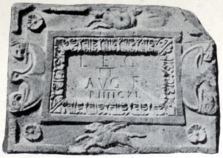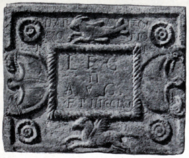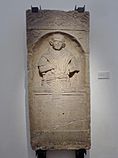Legio II Augusta facts for kids
Quick facts for kids Second Legion Augusta |
|
|---|---|
| Legio II Augusta Legio Secunda Augusta |
|
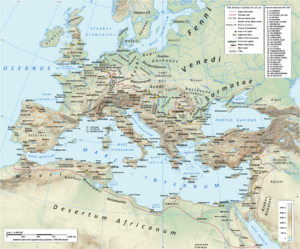
Map of the Roman empire in AD 125, under emperor Hadrian, showing the LEGIO II AUGUSTA, stationed at Isca Silurum (Caerleon, Wales), in Britannia province, from AD 74 to at least 269
|
|
| Active | 43 BC to sometime in the 4th century AD |
| Country | Roman Republic and Roman Empire |
| Type | Roman legion (Marian) |
| Role | Infantry assault (some cavalry support) |
| Size | Varied over unit lifetime. Approx. 3,500 fighting men + support at the time of creation. |
| Garrison/HQ |
|
| Nickname(s) |
|
| Patron | Augustus |
| Mascot(s) | Capricornus, in its sea-goat form the astrological sign of II Augusta's patron, Augustus |
| Engagements |
|
| Commanders | |
| Notable commanders |
|
The Legio II Augusta (which means "Second Legion of Augustus") was a famous and powerful group of soldiers in the Roman Empire. It was first formed during the late Roman Republic. This legion used symbols like the Capricornus (a mythical sea-goat), Pegasus (a winged horse), and Mars (the Roman god of war). It likely got its special name "Augusta" because of a big victory or a new organization that happened when Augustus was emperor.
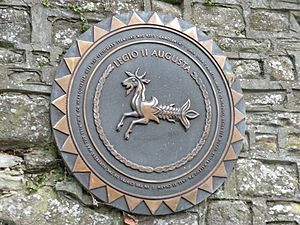
Contents
Early Days: The Roman Republic
The Legio II, also known as Sabina, was a Roman army unit from the time of the late Republic. It might have been created by Julius Caesar around 48 BC. If so, it would have fought against Pompey and taken part in the Battle of Munda in 45 BC.
Another idea is that the Legio II was formed in 43 BC by a consul named Gaius Vibius Pansa Caetronianus. It was recruited in a region called Sabina, which is why it got the nickname. If this is true, then it probably fought in the Battle of Philippi in 42 BC. In that battle, it would have been on the side of the three powerful leaders: Octavian, Mark Antony, and Lepidus.
After the enemies of these leaders were defeated, Legio II became loyal to Octavian. It stayed with him until the Battle of Actium in 31 BC. After this, it seems the legion was disbanded. Many soldiers were sent home, and some might have joined the new Legio II Augusta.
Serving the Roman Empire
Life in Hispania
When Augustus became the first Roman emperor in 26 BC, the Legio II Augusta was sent to northern Hispania Tarraconensis (modern-day Spain). Their mission was to fight in the Cantabrian Wars. These wars were important because they helped Rome fully control Hispania. While in Hispania, the legion worked with another legion, Legio I Germanica. Together, they helped build a Roman settlement called Acci and also constructed the city of Cartenna.
Moving to Germania and Gaul
A big disaster happened in 9 AD when several Roman legions were destroyed in the Battle of the Teutoburg Forest. Because of this, Legio II Augusta was moved to Germania, possibly near a place called Moguntiacum. In 15 AD, while in Germania, the legion joined campaigns led by Germanicus against the local Germanic tribes.
After Germanicus was called back to Rome, the legion was stationed at Argentoratum (modern-day Strasbourg, France). On their way back from Germania, the soldiers faced heavy rain and storms. Later, when Julius Sacrovir and Julius Florus led a revolt against Rome in Gaul, Legio II Augusta, under the command of Gaius Silius, helped to stop the rebellion.
Adventures in Britain
Invading Britain and Boudica's Revolt
The Legio II Augusta was one of four legions that took part in Emperor Claudius's invasion of Britannia (modern-day Britain) in 43 AD. The legion's commander at that time was Vespasian, who later became emperor himself. He led the legion in battles against the Durotriges and Dumnonii tribes. During this campaign, the legion marched across southern Britain, fighting many battles against the local people.
The legion was first based at Alchester. In 49 AD, it moved to Waddon Hill. From 55 AD, its base was at Exeter, and from 66 AD, it was possibly at Glevum (modern-day Gloucester).
The Year of Four Emperors
In 69 AD, during a time known as the Year of the Four Emperors, a part of Legio II Augusta (called a vexillation) supported Emperor Otho. When Otho was defeated, this group of soldiers switched sides and served Vitellius. They might have marched with Vitellius to Rome and fought in the battle at Cremona against Otho's legions. Later, these soldiers were defeated by Vespasian's forces and returned to Britain in 70 AD. It's thought that the main part of the legion had always been loyal to Vespasian.
Continuing Service in Britain
Julius Frontinus, who was the governor of Britain from 74 to 78 AD, ordered several campaigns against the Silures tribe in Wales. During these wars, the fortress of Caerleon in Wales was built. From 75 AD, Legio II Augusta was based there. The legion stayed at Caerleon even when Agricola was governor of Britain. However, some groups of soldiers from Legio II Augusta did fight in the Battle of Mons Graupius in Scotland.
In 139 AD, the legion helped build the Antonine Wall, which was used for only a short time. Between 155 and 158 AD, a revolt spread across Britain. Legio II Augusta was one of the legions that fought to put down this uprising. The Roman legions in Britain suffered heavy losses, and reinforcements had to be brought in from other Roman provinces in Germania.
In 196 AD, Decimus Clodius Albinus, the governor of Britain, declared himself emperor. Legio II Augusta supported his claim. However, Albinus and his legions were defeated by the current emperor, Septimius Severus. While the legions were away fighting, the province of Britain was attacked by Pictish tribes from the north. Emperor Severus tried to conquer Scotland to stop these tribes. While Severus was fighting the Picts, Legio II Augusta was stationed at a fort near Carpow.
At some point, the Legio II Augusta received the special name Antonina. This meant that the soldiers were particularly favored by the emperor. This happened either under Emperor Caracalla or Heliogabalus.
During Severus Alexander's time as emperor, the Roman conquests in Scotland were given up. The Second Legion then returned to Caerleon. The legion was still there in 255 AD. The last known mention of the legion is in a document called the Notitia Dignitatum. This document places the legion at Richborough, which suggests that Caerleon had been left behind.
Images for kids
See also
 In Spanish: Legio II Augusta para niños
In Spanish: Legio II Augusta para niños
- List of Roman legions
- Roman legion


